The image of a dog with a bone is timeless, deeply embedded in our culture and understanding of canine nature. From classic idioms to toys found in pet stores, the association of dogs and bones is as natural as it gets. This isn’t just a stereotype; it stems from a fundamental need and benefit for our carnivorous companions. For dog owners seeking high-quality, safe, and nutritious chewing options, the question often arises: “Where can I find raw dog bones from a butcher near me?”
This comprehensive guide will delve into the world of raw bones, clarifying the distinctions between edible and recreational types, outlining their numerous benefits, and providing essential safety precautions. Crucially, we’ll focus on how to responsibly source these valuable additions to your dog’s diet, with a special emphasis on local butchers, ensuring you make informed choices for your furry friend’s health and happiness.
Understanding Raw Bones for Dogs: Edible vs. Recreational
Not all raw bones are created equal, and understanding their distinct purposes is key to responsible feeding. Raw bones are broadly categorized into two main types:
Edible Bones (Raw Meaty Bones – RMBs)
These are raw, uncooked pieces that include meat, bone, tissue, and cartilage. They are designed to be entirely consumed by carnivorous dogs and are a vital component of a balanced raw diet, helping to meet the nutritional requirements for bone content. Edible bones typically come from smaller animals such as chicken, quail, duck, rabbit, turkey, or pork.
Raw meaty bones (RMBs) are crucial for raw feeders to provide essential minerals like phosphorus and calcium, along with other trace minerals vital for overall health.
Recreational Bones
In contrast to edible bones, recreational bones are raw, uncooked bones primarily intended for chewing, not for eating whole. They often contain marrow and are covered with a small amount of meat and tissue. Both raw-fed and kibble-fed dogs can enjoy these as a supplement, offering mental stimulation and dental benefits.
Recreational bones usually come from larger, more robust animals like bison, cow, elk, moose, or deer. They are typically sourced from strong, weight-bearing areas such such as the knuckle, femur, shank, rib, tibia, or hip.
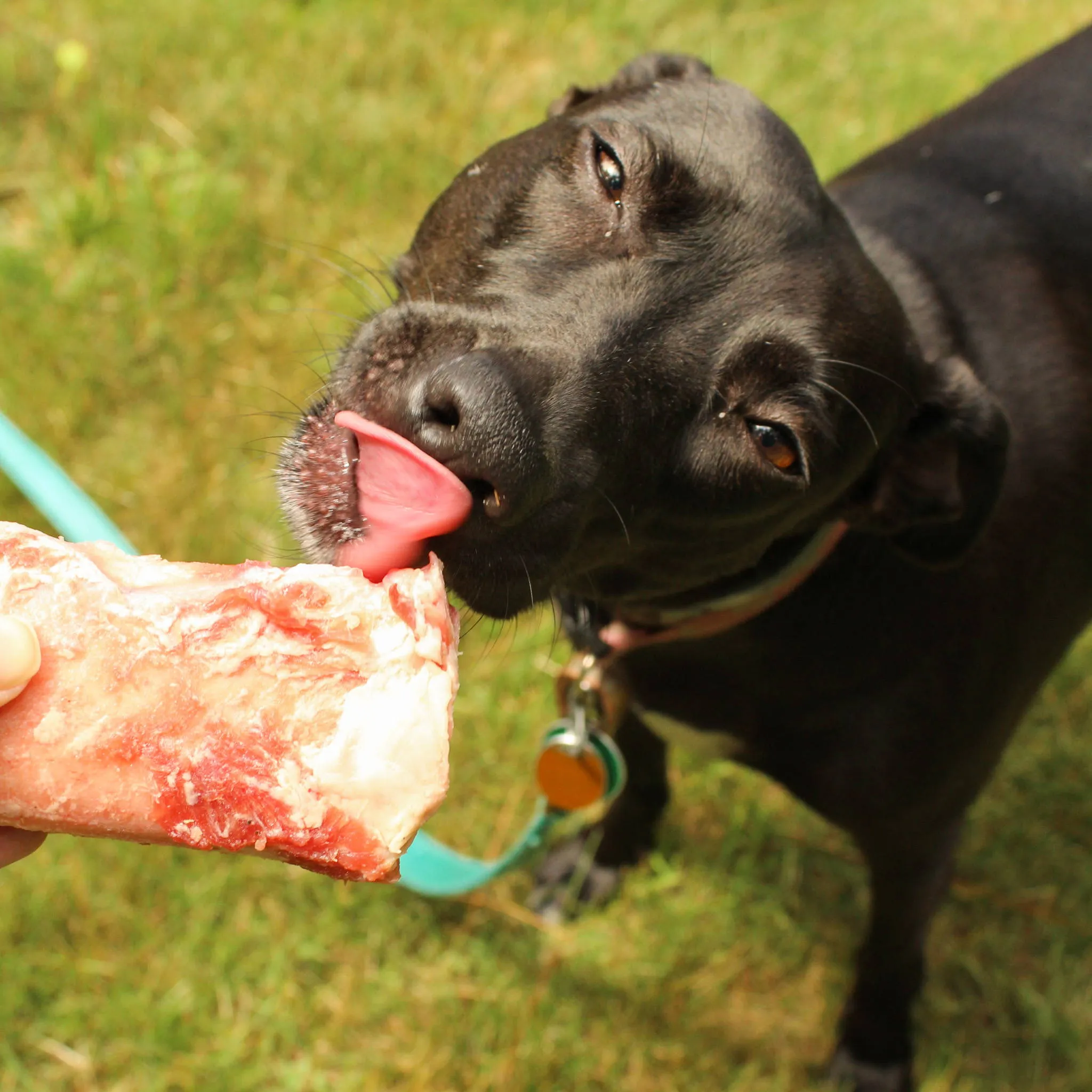 A happy black dog enjoying a raw beef bone, highlighting the natural appeal of raw dog bones from a butcher near me.
A happy black dog enjoying a raw beef bone, highlighting the natural appeal of raw dog bones from a butcher near me.
The Multifaceted Benefits of Raw Bones for Dogs
Raw bones offer a wealth of advantages for dogs, impacting both their physical health and mental well-being.
Benefits of Edible Bones
- Promotes Healthy Digestion: The fibrous and tissue content of bones binds to food in the digestive tract, aiding digestion and firming up stools, which helps prevent issues like runny stools.
- Provides Essential Minerals: Consuming raw meaty bones allows dogs to naturally absorb crucial minerals such as calcium and phosphorus. These minerals are indispensable for strong teeth and bones, as well as supporting optimal organ and tissue function throughout the body.
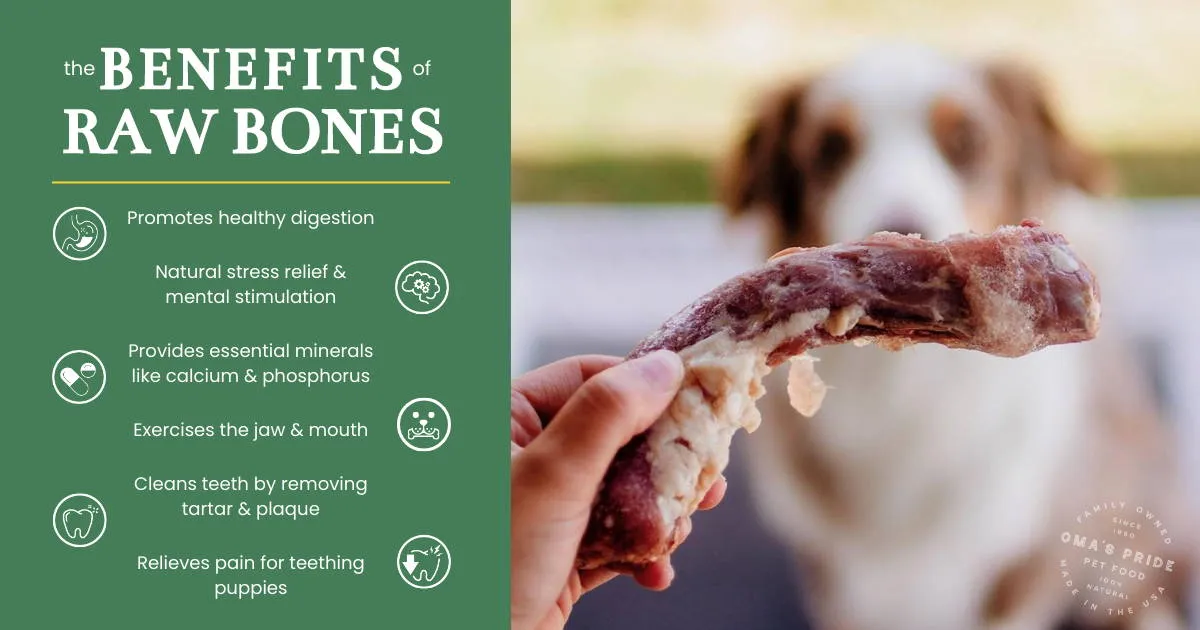 Infographic illustrating key benefits of raw bones for dogs, with a close-up of a dog enjoying a chicken neck, an excellent edible raw bone option.
Infographic illustrating key benefits of raw bones for dogs, with a close-up of a dog enjoying a chicken neck, an excellent edible raw bone option.
Benefits of All Raw Bones (Edible & Recreational)
- Natural Release for Carnivores: Chewing is an instinctive behavior for carnivores and provides vital mental stimulation. The challenge of tearing and gnawing on a bone acts like a puzzle, releasing endorphins that help alleviate boredom and reduce unwanted destructive chewing behaviors.
- Exercises the Jaw and Mouth: The act of chewing vigorously on a raw bone helps maintain the strength of your dog’s mouth, jaw, neck, and shoulder muscles.
- Cleans Teeth by Removing Tartar and Plaque: Raw bones are arguably the most natural and effective way to maintain your dog’s dental hygiene. The abrasive action of gnawing helps scrape away plaque and tartar buildup, contributing to cleaner teeth and healthier gums, significantly reducing the risk of gum disease.
- Relieves Pain for Teething Puppies: Puppies experience discomfort as their adult teeth emerge. Providing a suitable raw bone to chew on can offer significant pain relief during this period, simultaneously reducing anxiety.
- A Healthy Alternative to Rawhide: Many pet owners are aware of the potential dangers of rawhide, which is often difficult to digest, made with chemicals, and can pose choking or blockage risks. Raw meaty bones and recreational bones offer a natural, safer, and more beneficial alternative for entertaining dogs and promoting dental health.
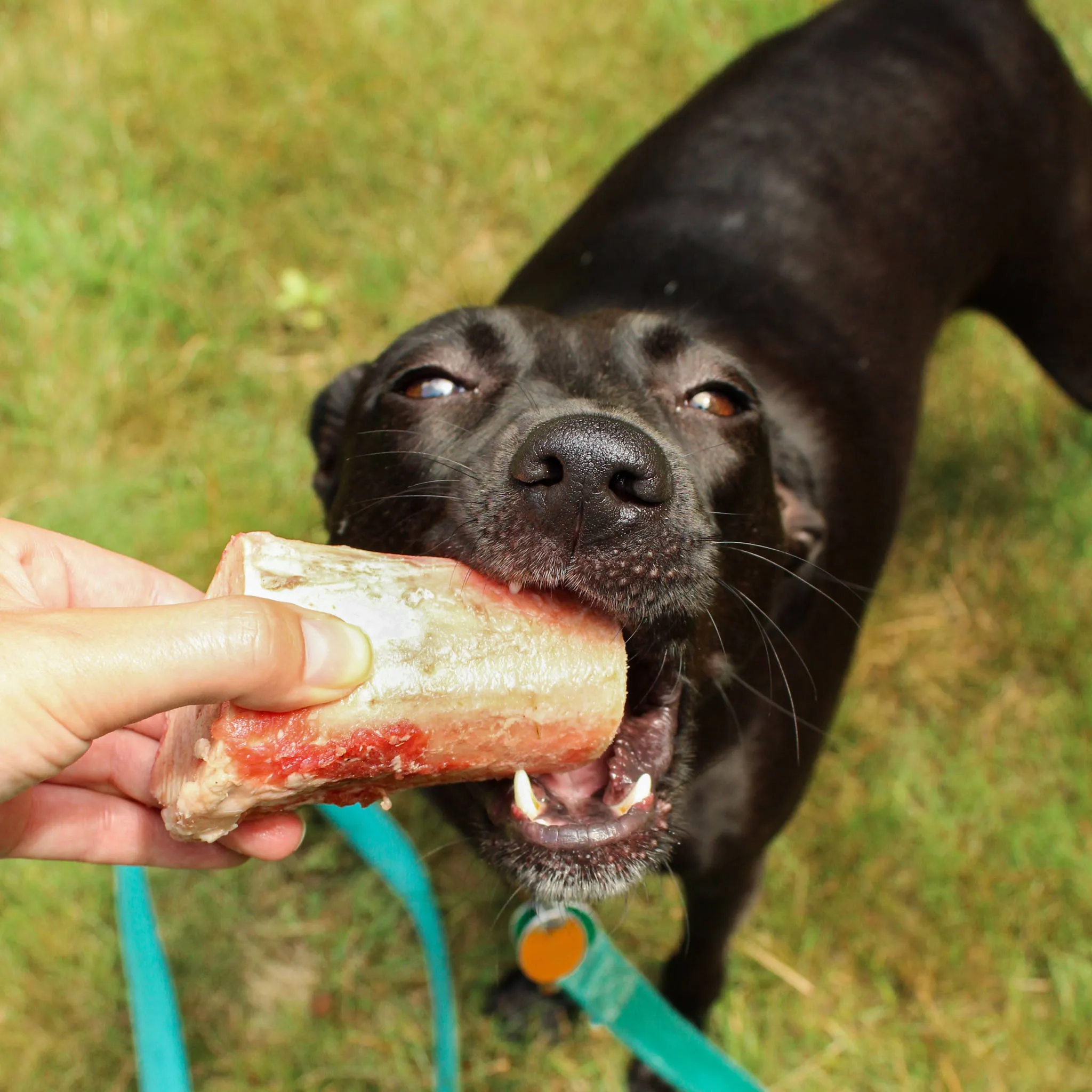 A black canine companion intensely chewing on a large raw bone, demonstrating the dental benefits of natural chews.
A black canine companion intensely chewing on a large raw bone, demonstrating the dental benefits of natural chews.
Going Deeper: All About Edible Bones
Edible raw bones, when incorporated into a dog’s balanced diet, are powerhouses of nutrition. Beyond phosphorus and calcium, these bony animal pieces—complete with meat and tissue—also supply protein, iron, collagen, essential fatty acids, various vitamins, and amino acids.
Edible bones are typically softer and often hollow, encased in meaty tissue and cartilage. Poultry bones are a popular choice among raw feeders due to their smaller size and softer composition. However, it’s important to remember that not all bones are suitable for raw, whole consumption, even from poultry. For instance, weight-bearing bones from larger birds can be denser and more prone to splintering, making them unsuitable as RMBs.
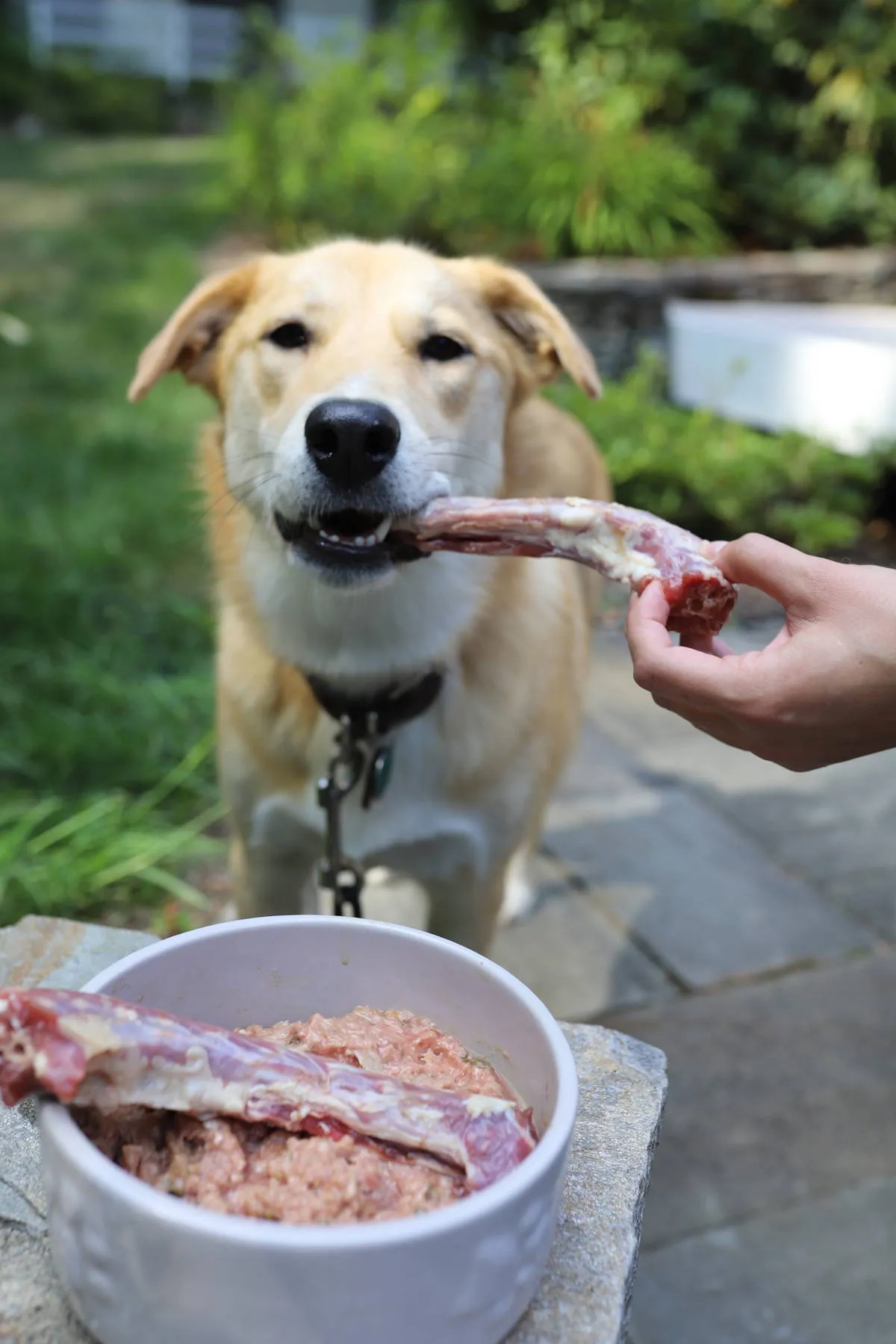 An adorable yellow puppy holding a small raw meaty bone (RMB), emphasizing proper sizing for puppy raw bones.
An adorable yellow puppy holding a small raw meaty bone (RMB), emphasizing proper sizing for puppy raw bones.
How to Get Started with Edible Bones
If you are transitioning your dog to a raw diet from kibble, it’s advisable to wait 7-10 days before introducing raw meaty bones. This allows their digestive system to adjust.
Please note! While highly beneficial for many, raw meaty bones are not universally suitable. Dogs with weakened enamel, other compromising dental issues, overly aggressive chewing habits, or a general disinterest in chewing may not thrive on RMBs. Consult your vet if unsure.
When you begin, start cautiously with smaller pieces, such as a duck foot, and gradually increase the size of the RMB to match your dog’s size and chewing ability.
Always thaw bones from the freezer in the refrigerator for 24 hours before feeding. Place the RMB in your dog’s bowl in an appropriate chewing area. If mess is a concern, use a towel or feed them outdoors on an easily cleanable surface.
How to Calculate Bone Percentage
Beginning raw feeding can seem daunting, but calculating bone content is manageable. The goal is to balance phosphorus and calcium, aiming for roughly a 1:1 ratio.
Raw feeding tip! As a general guideline, edible bones should constitute about 10-15% of your dog’s total daily raw diet.
The bone content varies significantly between different types of edible bones. For example, a turkey neck may contain around 45% bone, while a chicken foot can be about 60% bone. You can find detailed bone content percentages for various RMBs through resources like PerfectlyRawSome.com.
Here’s a simplified calculation example:
- Select a Raw Meaty Bone: Let’s use Whole Chicken Necks.
- Calculate Daily Food Requirement: For a 50-pound dog like Lyra, maintaining her weight, a general guideline is 2.5% of body weight in food per day. So, Lyra needs approximately 1.25 pounds of food daily.
- Calculate Bone Amount: If feeding skinless chicken necks (approximately 60% bone content) and aiming for 14.4% bone in the diet, you would feed 0.3 pounds of chicken necks per day (0.3 lbs ÷ 1.25 lbs total food = 24% of her overall diet, then 60% bone content x 0.24 = 14.4% bone).
It’s crucial to monitor your pet’s stool to adjust bone content. Hard, chalky, or white stools indicate excessive bone, while watery or loose stools may suggest insufficient bone.
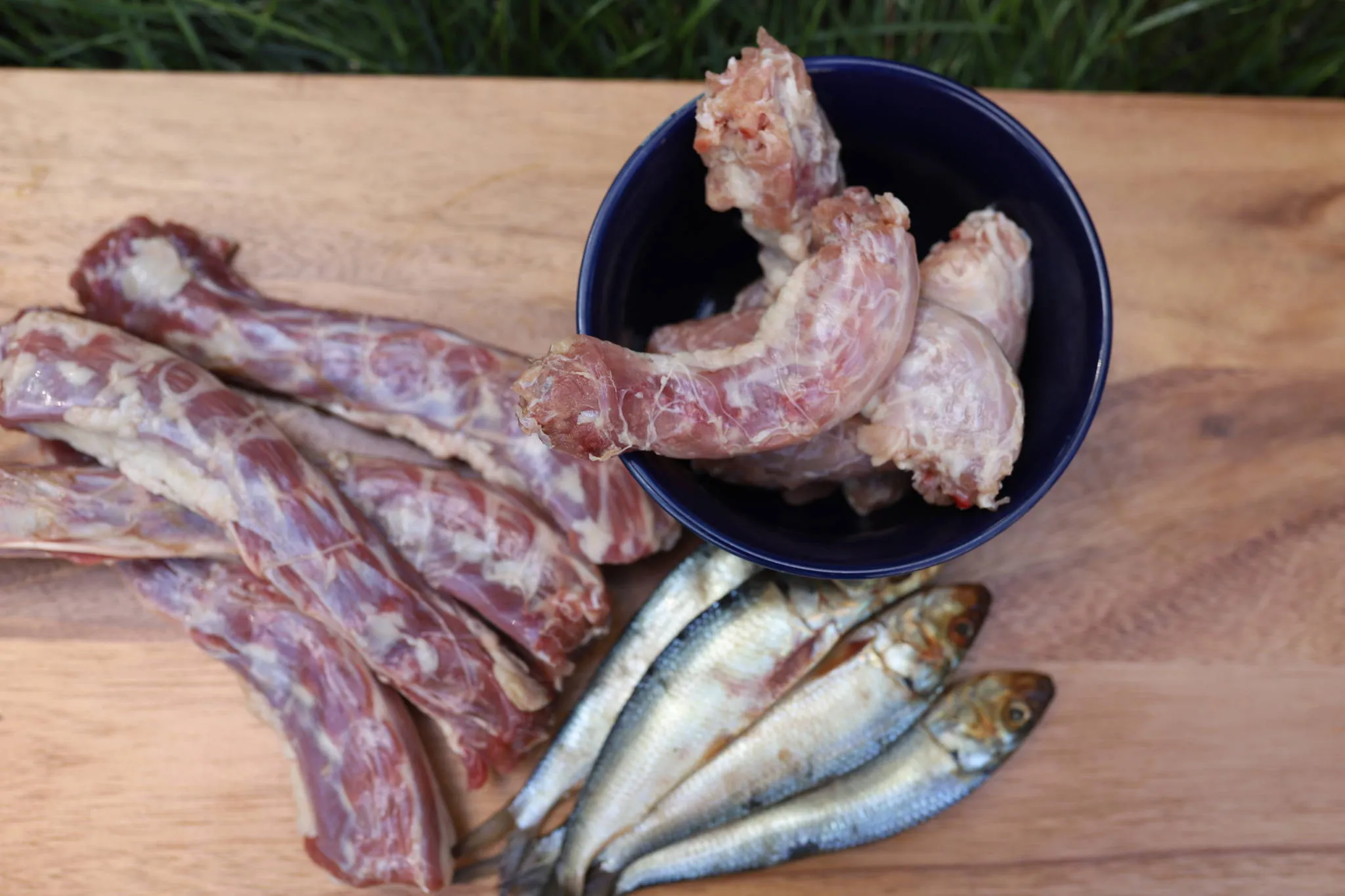 A selection of edible raw bones including chicken necks, turkey necks, and sardines, perfect examples of raw meaty bones for dogs.
A selection of edible raw bones including chicken necks, turkey necks, and sardines, perfect examples of raw meaty bones for dogs.
Alternatives to Whole Raw Meaty Bones
For dogs who cannot consume whole RMBs, several alternatives can help achieve dietary balance:
- Green Tripe: Similar to RMBs, green tripe offers a naturally balanced calcium and phosphorus ratio (around 1:1), crucial for a complete diet.
- Other Supplements: Food-grade bone meal (preferably not heat-treated) formulated for pets is an option. Some companies offer seaweed or coral calcium, but precise balancing of calcium and phosphorus is essential. Products like Four Leaf Rover “Better Bones” (freeze-dried beef bones) also serve as excellent alternatives.
- Ground Meat and Bone Mixes: Many raw food suppliers offer pre-ground mixes that incorporate bone, allowing your dog to benefit from bone nutrients without needing to chew on a whole RMB.
Appropriate Edible Bones (Based on Pet Size)
Choosing the correct size and type of edible bone based on your dog’s size is paramount for safety and efficacy.
- Necks: Chicken necks are suitable for dogs and cats of all sizes. Duck necks are better for medium-sized dogs, while turkey necks are ideal for larger breeds.
- Whole Animal: Whole sardines, mackerel, and quail are appropriate for dogs and cats of all sizes.
- Wings: Chicken wingettes, wing tips, and drumettes are safe for all sizes. Duck wings suit medium-sized dogs and up. Turkey wings are best for large dogs (removing the dense drumette first is recommended).
- Feet: Chicken and duck feet are excellent for all pets due to their high content of tissue and ligaments. Pork feet are more appropriate for large dogs but should be fed in moderation due to higher fat content.
- Frames: Chicken and duck frames can be fed to pets of all sizes.
- Tails: Larger tails from pigs, turkeys, goats, lambs, or oxen are best for medium-sized dogs and up. Smaller tails, if found, may be suitable for smaller pets.
- Ribs: Lamb or pork ribs should be reserved for large dogs.
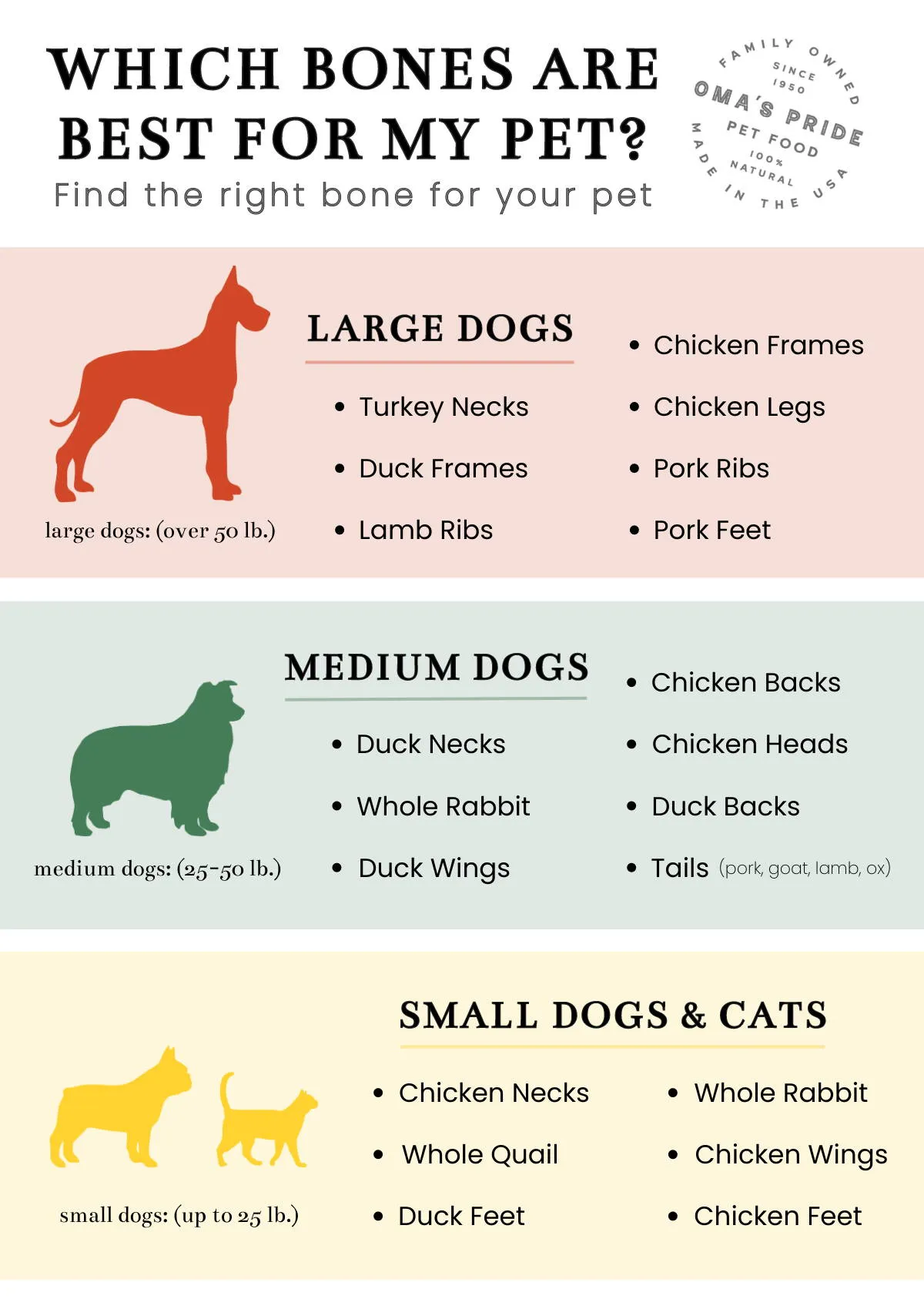 An informative graphic categorizing raw meaty bones (RMBs) by dog size, ensuring safe and appropriate raw bone selection for small, medium, and large breeds.
An informative graphic categorizing raw meaty bones (RMBs) by dog size, ensuring safe and appropriate raw bone selection for small, medium, and large breeds.
Going Deeper: All About Recreational Bones
Recreational bones, as their name suggests, are primarily for chewing enjoyment and mental stimulation, not for whole consumption. They are generally larger and denser than edible bones.
Selecting the appropriate size is crucial to prevent your dog from attempting to swallow it whole or injuring themselves. Larger marrow and knuckle bones are ideal for medium to large dogs, while smaller rib bones are more suitable for smaller animals.
Important note! Recreational bones do not provide sufficient amounts of phosphorus or calcium to replace raw meaty bones or bone meal in your dog’s diet. Consider them a treat or supplement rather than a dietary staple.
Types of Recreational Bones
Recreational bones are typically sourced from the large, weight-bearing bones of animals such as cows, buffalo, bison, elk, deer, or moose. Common cuts include the femur, tibia, shank, or hip areas.
How to Feed Recreational Bones
When offering a recreational bone, you can give it directly from the freezer or allow it to thaw slightly, depending on your dog’s chewing style. Less aggressive chewers might prefer a slightly thawed bone.
It’s best to limit feeding raw beef marrow bones to about 20 minutes at a time, 1-2 times per week. Marrow is rich in fat and can lead to digestive upset if consumed too frequently.
Here are some tips for a safe and positive experience:
- Choose the Right Location and Setting: Raw bones can be messy. Feed them outdoors, on a towel, or on another easily sanitizable surface. Avoid distracting environments (e.g., around new dogs or people) to minimize resource-guarding behaviors.
- Teach the “Drop It” Command: Ensure your dog is proficient in the “drop it” command. This allows you to safely intervene if a bone becomes a hazard or if you need to end the chewing session.
- Feed After a Meal: Giving a recreational bone after your dog has eaten a full meal can reduce aggressive chewing, as they are less likely to overindulge.
- Use as an Exercise Alternative: On days when outdoor exercise isn’t feasible (e.g., due to extreme weather), recreational bones provide excellent mental stimulation and a healthy outlet for energy.
- Follow Safe Raw Food Handling Techniques: Always wash your hands thoroughly after handling raw bones, sanitize all surfaces, and store leftover bones in the refrigerator or freezer to maintain safety and freshness.
Safety Precautions When Feeding Raw Bones
While feeding raw bones is generally safe and beneficial, proactive awareness of potential risks is essential.
First, understand your dog’s chewing habits and temperament. Start slowly with smaller, more manageable pieces before progressing to larger, whole bones once you are comfortable with their chewing behavior.
Though rare, choking, splintering, and intestinal blockages can occur with raw bones. Consistent supervision during chewing sessions is paramount, allowing you to intervene quickly if an issue arises.
Safety tip! Never feed cooked, smoked, roasted, boiled, or any heat-processed bones. Heat removes moisture, making bones brittle and prone to splintering into sharp fragments that can severely injure your dog’s teeth and internal organs.
Sourcing Quality: Where to Find Raw Dog Bones from a Butcher Near You
Now that you understand the benefits and precautions, the critical question is, “Where can I buy raw dog bones from a butcher near me?” Sourcing quality raw bones is crucial for your dog’s safety and health.
Generally, excellent sources include:
- Online Pet Retailers: Many specialized online stores offer a wide variety of raw bones, often from reputable, pet-focused suppliers.
- Local Farmer’s Markets: These markets can be a fantastic place to connect directly with local farmers who raise animals and may offer suitable raw bones. Ask about their animal husbandry practices.
- Local Raw Co-ops: Raw feeding cooperatives are communities of pet owners who band together to purchase raw pet food and bones in bulk, often at better prices and with direct access to quality suppliers.
- Local Butchers: For many, a local butcher is the ideal place to find raw dog bones from a butcher near me. Butchers often have fresh, high-quality bones available, and you can establish a direct relationship.
Tips for Sourcing from a Butcher:
- Communicate Your Needs: When visiting a butcher, clearly state that you are looking for raw dog bones for canine consumption. This distinction is important because standard machine-cut bones not intended for raw consumption can have sharp, dangerous edges. A knowledgeable butcher can provide bones processed safely for dogs.
- Ask About Bone Types: Inquire about specific types of bones (e.g., beef marrow, knuckle, chicken necks, lamb ribs) and ask for recommendations based on your dog’s size and chewing habits.
- Inquire About Sourcing: A good butcher should be able to tell you where their meat comes from, including information about the animals’ diet (e.g., grass-fed, organic).
- Freshness and Storage: Ask about the freshness of the bones and how they should be stored until you get them home. You want bones that have been properly handled and stored to minimize bacterial growth.
It’s generally not recommended to feed dogs raw bones or meat from standard grocery stores, as these are primarily intended for human consumption and typically stored at refrigerated temperatures that, while safe for humans who will cook the meat, can foster bacterial growth that might be problematic for raw feeding, especially if not consumed immediately. Grocery store meats are generally meant to be fully cooked before consumption.
Frequently Asked Questions
Can dogs eat bones?
Yes, most dogs can safely eat whole raw meaty bones (as part of a balanced diet) and recreational bones (for chewing and mental stimulation). However, whole bones may not be suitable for overly aggressive chewers or dogs with existing dental problems.
Are raw bones safe for dogs?
Raw bones are safe for dogs if you select an appropriate size bone for your dog, monitor them closely while they chew, and source the bones from a trusted pet retailer, local raw co-op, or a knowledgeable butcher who understands your needs.
